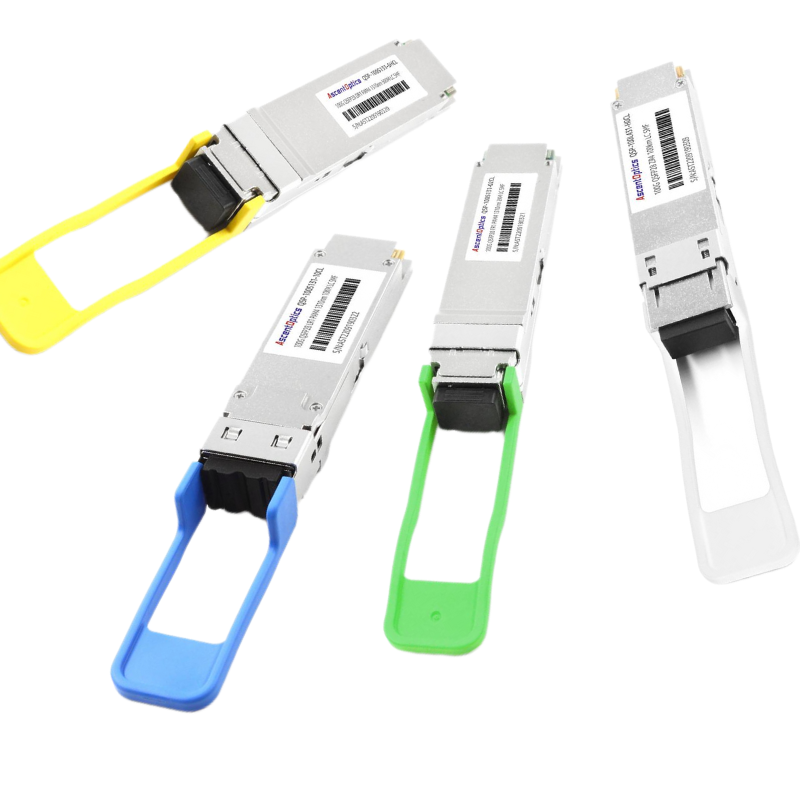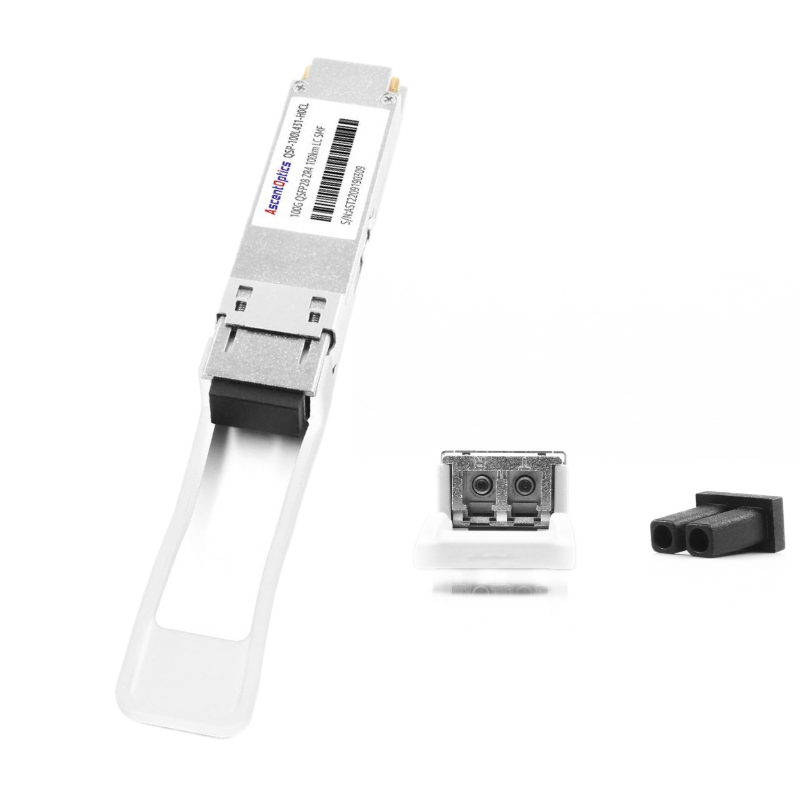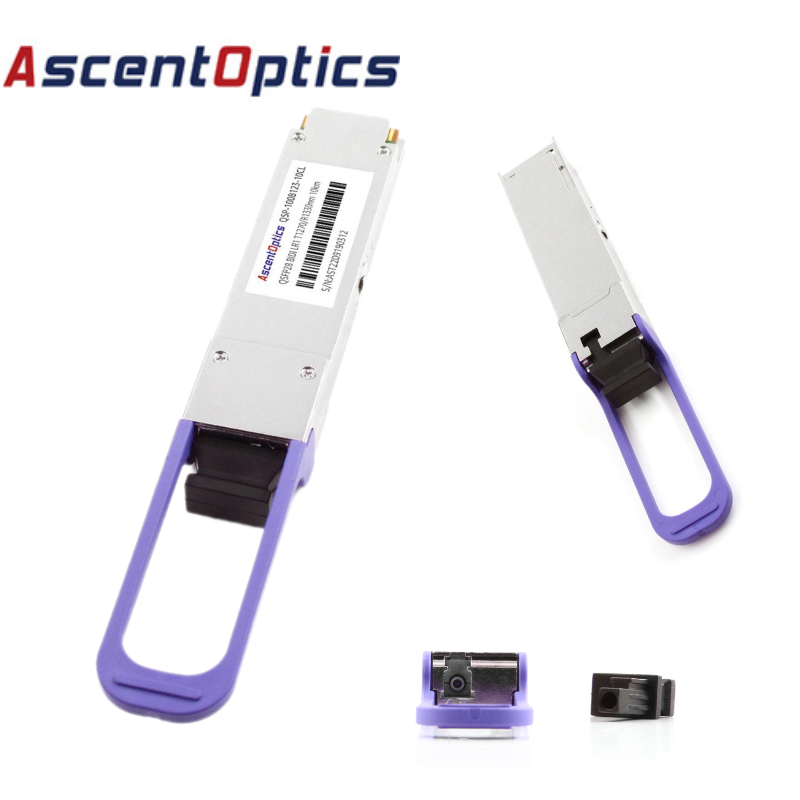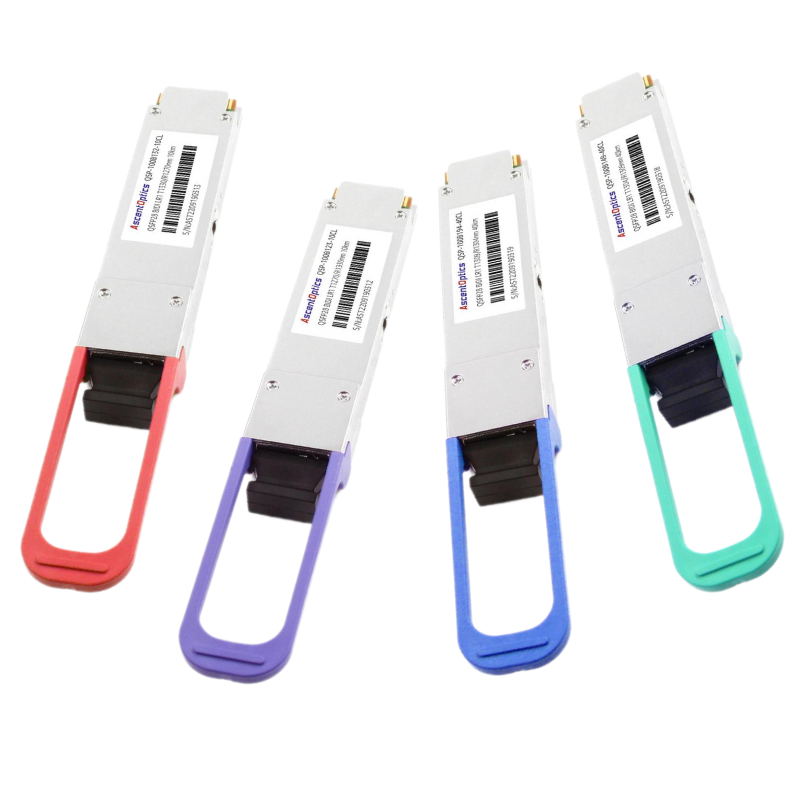QSFP28 transceivers are created to provide support for high-speed data transmission rates of up to 100Gbps, which makes them suitable for data centers, high-performance computing networks, and other bandwidth-intensive applications. These modules comply with the multi-source agreement (MSA) for QSFP28 thus ensuring that they can work with different hardware vendors as well as network environments.
A number of main features have been incorporated into the design of QSFP28 transceivers for better performance and reliability:
These qualities make them indispensable for any modern communication network where speed is required without compromising on efficiency and interoperability at the same time.
The versatility of these devices makes it possible for them to be used in various types of high-speed networking environments such as:
By meeting all these different demands, qsfp28 transceivers significantly contribute towards advancing network technology as well as infrastructure development.

A 100G QSFP28 optical transceiver is an integral part of fast data communication systems. These systems are made to support 100GbE (Gigabit Ethernet). It can work on single-mode or multi-mode fiber. Some of its features include:
These are the elements that make up a hundred gigabit small form factor pluggable optical module according to this definition, indicating how essential they are within contemporary infrastructures supporting higher speeds and greater densities like those found in data centers or enterprise networks.
The advent of QSFP28 transceiver has brought about significant changes compared to other transceiver form factors such as SFP+ and CFP. The following are the main differences:
Having these differences at hand will enable network engineers or IT professionals to select the right transceiver form factor for their networking needs based on performance requirements.
For the best performance on different network settings, it is important that one ensures that they have used the right wavelength as well as made their devices compatible with others. Common wavelengths for QSFP28 modules are 850nm (Multimode Fiber or MMF) and 1310nm (Singlemode Fiber or SMF). This helps to keep signal integrity intact while achieving the required reach and data rate.
These devices should be made compatible with those from other vendors through adherence to such industry standards like IEEE 802.3ba or Multi-Source Agreement (MSA) specifications, which allow them to work together seamlessly when plugged into each other. They can also be used with already existing hot-swappable infrastructure for 100G Ethernet, thus making it possible for easy upgrades and deployments where necessary. Additionally, these transceivers may be backward-compatible with previous generations of themselves, like 40G QSFP+, hence offering more options as well as protecting future investments.
To sum up, getting the right wavelength selection coupled with ensuring compatibility greatly enhances effectiveness of any given system employing 100 gigabit per second quad small form-factor pluggable plus module; this guarantees robustness in performance across wide area networks.

Optimizing a network by utilizing 100G Ethernet as well as QSFP28 transceivers can be done in several ways according to industry experts. First, one needs to have a solid foundation when it comes to high-speed data transfer through building a robust infrastructure that is able to support the scale and efficiency required in today’s servers. It is important that organizations use advanced modules like QSFP28 for increased throughput, which also helps reduce delay times, especially when dealing with huge amounts of information found within large environments.
Secondly, introducing 100 gigabit ethernet greatly increases bandwidth capacity thus allowing better performance for cloud computing, high-frequency trading or even big data analytics. These transceivers are designed such that they consume less power while at the same dissipate heat more efficiently hence minimizing downtimes during operation.
The maximum potential of 100GbE may also be realized by following industry standards including IEEE 802.3bm which defines properties for different types of interfaces used at this speed thereby ensuring interoperability between various vendors’ devices as well as preparing networks against future developments.
Last but not least important thing is identifying where exactly Qsfp28s should be placed strategically across the network after taking into consideration current traffic levels within each segment vis-a-vis projected growth rates so that there can be balanced loads among them, leading to optimal resource utilization besides guaranteeing the ability to meet present requirements without locking out expansion opportunity later on.
In conclusion, integration of these two technologies can result into higher speeds within systems apart from scalability improvements and operational efficiencies over long run in centers processing massive volumes of digital information.
When choosing between single-mode (SMF) & multimode (MMF) qsfp28s, it becomes critical to determine specific distance requirements vis-à-vis bandwidth needed by an application. Single-mode transceivers are designed for long-range data transmission, which may go beyond 10 km, mostly used in wide area networks (WANs) or connecting DCs (Data Centers). They operate at a wavelength of 1310 nm with higher capacities, albeit expensive due to component complexity during manufacturing processes.
On the other hand, multimode qsfp28s are meant for short distances, like within buildings not exceeding 400 m; hence, they are best suited for local area network (LAN) connections, including those found between servers inside the same facility. Their wave lengths stand at 850nm, and they come cheaper because their components can be made easily as well as installed quickly, though this is accompanied by reduced distance coverage together with bandwidth capacity when compared against single mode versions.
Choosing the right type depends on various factors such as distance covered, speed required, cost implications, and scalability plans going forward therefore, all these aspects need to be evaluated carefully before settling down with any particular kind based on what suits your needs most without compromising current operations too much
100G connectivity is improved through the use of high-density fiber connections that multi-fiber push-on connectors provide and allow efficient data transmission in high-performance networks. In contrast with traditional single-fiber terminations, multi-fiber terminations using one interface called MPO (Multi-Fiber Push On) connectors are designed to support many fiber connections, thus saving a lot of time and reducing complexity in this way. These become very important within space, time, and performance-sensitive environments such as data centers or high-speed networks.
MPO connectors are often used together with QSFP28 transceivers, which require parallel optics to achieve 100G speeds. The multiple fibers are brought into just one connector by the MPO technology, which supports higher rates of data as well as reduces the number of connections; hence, insertion loss and overall network performance is improved too. Furthermore, they allow an easy transition from 10G to 40G then later on towards 100G and beyond while still keeping it simple for future upgrades and scalability during network expansion periods.
Therefore we can say that without MPO connectors it would not be possible to have neat organization of fibers, increased data throughput as well as reliable fast connectivity at modern data centers rated at 100 gigabits per second. This is a cheap method because apart from satisfying wider bandwidth demands; their usage ensures continued robustness in network performances even where resources are limited.

When deploying QSFP28 modules from Cisco, Arista, and Juniper, among other industry leaders, into existing networks, there are several compatibility factors that must be considered for smooth integration as well as optimum performance.
Cisco: Cisco’s QSFP28 modules are designed for high-density and low-power consumption 100G applications; they support different 100G standards such as CWDM4, PSM4, and LR4. These devices can be plugged into any compatible switch or router made by the same company, which makes upgrading them easy without having to reconfigure the whole network.
Arista: Arista has various types of switches, including their 7000 series and also 7500 series switches, which are compatible with a range of QSFP28 transceivers; this provides high-performance connectivity over one hundred gigabits per second data rates. They use EOS (Extensible Operating System) software that supports automation as well as advanced monitoring capabilities, making it simpler to manage large numbers of these ports within an environment where many hundred Gigabit Ethernet interfaces may be required.
Juniper: Juniper offers different kinds of routers, such as their PTX series along with QFX switches. Both come equipped with support for bandwidth needs found in modern-day data centers where these need to connect at speeds either above or equal to 100 Gbps. The operating system used here is Junos OS, which allows seamless integration while also offering features like Virtual Chassis plus DCIs, thus reducing time taken during migration towards higher capacity links.
In conclusion; Cisco Systems Inc., Arsta Networks Inc., and Juniper Networks all have their own versions of what they call “QSFP+” modules – but all three companies’ offerings are aimed at ensuring that these devices can work easily alongside other hardware produced under each firm’s brand name. For best results, it is important to ensure both transceivers as well as existing infrastructure support, require standards for 100Gbps Ethernet and that network management systems are able to handle increased bandwidth demand.
Various QSFP28 variants have been designed for different application needs and distance limitations in 100G networks. The 100GBASE-SR4 variant uses multimode fiber (MMF) and operates over four lanes, covering a maximum of 100 meters for short-range applications. On the other hand, the 100GBASE-LR4 variant supports single-mode fiber (SMF) and can span distances of up to 10 kilometers which makes it most suitable for data center interconnects within this range. For even longer connections, there is an option known as 100GBASE-ER4; this particular type also operates via SMF but extends reach up to forty kilometers. These choices offer flexibility during network planning since they allow one to select modules based on either the required distance or the existing infrastructure available.
While deciding on the best cabling option for 100G transceivers, it is important to know the advantages and disadvantages of Active Optical Cables (AOCs) and Direct Attach Cables (DACs) since each has its own merits that suit different types of networks.
Pros:
Cons:
Pros:
Cons:
To sum up, whether one chooses active optical cables or direct attach cables will depend on their network needs, such as distance requirement, budget allocation for power consumption, and complexity of deployment, among others. Knowing these trade-offs can enable a network engineer to optimize his or her 100G infrastructure accordingly.

There is a rapid growth of data generation and consumption which is driving the demand for more bandwidths as well as efficient network infrastructure. The solution to this need lies in advancing towards 400G networking and beyond.
400G Ethernet technology offers improved performance through higher data transfer rates, much better scalability, and increased efficiency within data centers. In environments with data-intensive applications, 400G solutions are four times larger than those of 100G hence addressing issues related to bandwidth bottlenecks. Among the key breakthroughs include coherent optics, such as silicon photonics integration that enables scalable optical interconnects besides other advanced modulation techniques like PAM4 (Pulse Amplitude Modulation).
Next-generation transceivers designed for supporting speeds of up to 400 gigabits per second (Gbps) include OSFP (Octal Small Form-Factor Pluggable) and QSFP-DD (Quad Small Form-Factor Pluggable Double Density) which offer higher port densities coupled with reduced operational expenses. Higher speeds alone do not define the move towards 400gbs and beyond but also make networks agile enough to handle exponential growth rates experienced in traffic volumes today. Flexibility demands brought about by increasing levels of digitalization will require certain developments like these ones be put into place so that it becomes possible for systems to adapt quickly enough whenever there is need for change.
Looking at what lies further ahead, various innovations being made around optical technology together with network architecture improvements driven by high-performance computing requirements are pushing forward advancements up to 800gbs as well terabit ethernet, i.e.,1.6Tethernet. Such future milestones shall continue transforming high-speed connectivity standards thereby setting new records in terms of how much data can be managed at any given time across different points within an organization’s infrastructure while ensuring that all these points remain connected together seamlessly without any interruptions whatsoever.
Doubling data rate efficiency in optical transceivers can be achieved through Pulse Amplitude Modulation 4-level (PAM4) which is a modulation scheme. Unlike Non-Return-to-Zero (NRZ) modulation where one bit gets transmitted per symbol, PAM4 sends two bits using four distinct pulse amplitude levels. This way, the baud rate remains the same, but the data rate effectively doubles, thus increasing bandwidth without having to significantly raise transmission frequency.
However, this higher efficiency comes at the expense of reduced signal-to-noise ratio (SNR) due to smaller spacing between each of those four different amplitudes. These impacts are mitigated by advanced error correction techniques and linearity improvements within designs thereby ensuring that there exists reliable high-speed data transmission. The use of PAM4 modulation is key to meeting modern-day 400G as well as future 800G Ethernet standards for required data rates, hence enabling continuous evolution in fast network infrastructures.
Single Lambda 100G technology revolutionizes optical communications by achieving speeds of up to 100 gigabits per second over a single wavelength. Traditional methods often use multiple wavelengths or channels for transmitting 100gbs which complicates system design and raises costs. In contrast, Single Lambda does this with ease; it simplifies network architectures by employing advanced modulations such as PAM4 so that more information can be sent through each wavelength per time unit.
Not only does this reduce the complexity involved when dealing with optic transceivers, but it also improves cost-effectiveness along with power consumption metrics. Its implementation is critical to meeting low-latency higher-bandwidth requirements set forth by cloud infrastructure providers today, thus making them more affordable than ever before possible. The scalability aspect ensures compatibility with various ethernet standards to come, including 400Gbps plus beyond. Single Lambda represents a game changer in terms of increasing data throughput while minimizing Opex/Capex for high-speed network environments.

When choosing a 100G QSFP28 transceiver, there are some important things to consider so that it works well with your network infrastructure.
Speed
QSFP28 transceivers support 100G Ethernet but you should check the exact data rate requirement of your application. Different modules can have different data rates and this has to be compatible with your existing network equipment as well as future expansion plans.
Distance
The distance over which it can transmit is another factor that should not be ignored. There are various specifications of QSFP28 transceivers; some are short-range (SR) which are designed for connecting devices in the same data center up to 100 meters over OM4 multimode fiber (MMF), while others are long-range (LR) and can go up to 10 kilometers over single-mode fiber (SMF). The choice here depends on what will work best given your deployment’s needs.
Cable Type
Multimode fiber (MMF) or single-mode fiber (SMF) may be used depending on distance and application requirements. MMFs are good when working within shorter distances like those found within most data centers since they offer cost-effective solutions. On the other hand, SMFs become necessary where wider coverage areas need to be reached because they provide higher performance levels as well as better future-proofing capabilities for larger networks. It is also possible to select direct attach cables (DACs) or active optical cables (AOCs) for use where there is a need for short high-speed interconnects between racks.
By understanding these considerations, one can ensure that their chosen QSFP28 aligns with their network’s performance expectations, scalability, and budget constraints.
There is a wide range of network hardware that is covered by the MSA. A multi-source agreement or MSA is an agreement between several manufacturers to make standard specifications for optical transceivers. For QSFP28 modules, these standards cover electrical interfaces, mechanical dimensions, thermal requirements and communication protocols. By conforming to this standard, it means that any QSFP 28 module can work with any other vendor’s equipment making it easy to integrate and scale networks in different environments. This ensures that the transceiver meets tight restrictions on power consumption and performance, which are important for high-density data centers and future-proof network design.
Digital Optic Monitoring (DOM)
Digital Optic Monitoring usually called DOM is an imperative characteristic of a QSFP28 transceiver that gives current reports about how the module is operating. This involves recording such as optical power output, input power, temperature, laser bias current and receiver supply voltage. Network administrators can keep track for potential problems promptly through this feature thus increasing reliability in addition to maintenance throughout a network.
Data Rate
QSFP28 interfaces enable higher data rates which is why they work well with modern-day data centers as well as other networks. Commonly designed to handle data rates up to 100 Gbps are QSFP28 modules. Each lane can transmit 25Gbps hence there being four of them so as to achieve this rate. With regard to cloud computing, video streaming, or any other data-intensive application, these very high speeds are required because they help in dealing with an increased need for bandwidth.
Wavelength
This particular factor is highly significant when it comes to long-range communication using QSFP28 transceivers. Depending on the use case scenario; different modules may employ various typical wavelengths for their operations. For example, short reach (SR) transceivers will tend to use 850nm as the most common wavelength, while intermediate range (LR) ones could opt for 1310 nm, and extended range (ER) types may select 1550 nm, among others. The decision made here affects the distance covered before signal degradation occurs, not forgetting its implications on optical network planning and implementation.
Getting conversant with these details will go a long way into ensuring that you choose an appropriate QSFP28 transceiver for your network infrastructure thereby improving performance, compatibility and reliability at large.

URL: NetworkComputing.com/100g-sfp-importance
Summary: This online article from Network Computing talks about the importance of 100G SFP transceivers and how they can help in improving network connectivity speeds and efficiency. It discusses what 100G SFP modules are technically, which devices they work with, and their part in ensuring networks transfer data at very fast rates. If you need to know everything about where 100G SFP stands on modern network infrastructures, this is a must-read for you
URL: IEEE Xplore/100g-sfp-performance-analysis (Subscription may be required)
Summary: This scholarly article, which is available on IEEE Xplore, examines the performance of 100G SFP modules that were designed for use in data centers. The authors tested the modules using a variety of methods and report their results on transfer speed, reliability, and other factors related to performance. In addition to this information, they also compare these findings against those from different types of optical transceivers. Such knowledge can be very useful to network professionals or anyone working with data centers who wants some technical advice.
URL: Fiberstore.com/100g-sfp-guide
Summary: Fiberstore’s all-encompassing manual for 100G SFP transceivers provides a detailed description of the product, including its specifications; what it is compatible with in terms of other network equipment; as well as tips on how best to deploy them. Articles include fiber types and distance limitations among others such as power consumption and future trends in this field of technology. This resource from manufacturers can be used by those who need help understanding more about these technicalities when using them for networking purposes
In high-speed networking equipment, a 100G QSFP28 optical transceiver module is created to provide a data transmission speed of 100G over fiber optic cables. These modules come in various types to fit different network requirements, such as Cisco-compatible QSFP-100G-SR4-S and others. They have a networking device connecting port supported with the QSFP28 interface.
The QSFP28 100G module is designed for short-range communications, especially models like Cisco QSFP-100G-SR4-S supporting up to 100m when used with duplex LC multimode fiber which makes it perfect choice for intra-building or data center connections.
Yes they are compliant with multiple industry standards such as SFP-DD MSA which ensures interoperability and reliability in wide range of network environments. This compliance allows them to be easily integrated into existing networks without need for additional configurations.
A: The single-mode fiber (SMF optical transceiver module) is used for longer distances while multimode fiber is used for shorter distances as well as a variety of other media. Some models, such as the bidi (Bi-Directional) or the QSFP28 single lambda, allow different ways of connecting, which means they can work with many network architectures.
A: Yes, there are Cisco QSFP28 modules that are designed to transmit over longer distances. For example, the Cisco QSFP-100G-PSM4-S and Cisco QSFP-100G-DR-S can reach up to 2km and 500m, respectively, on single-mode fiber. These are great for inter-building connections within campus networks or across larger data centers.
A: The “28” in 28G data rate in QSFP28 modules refers to the per-channel transmission rate where each channel supports nearly 28 Gigabits per second (Gbps). Since these modules make use of four channels this gives them a total speed of slightly above ,100G which enhances capacity and efficiency for data centers and network backbones.
A: Yes, there are high density QSFP28 100G optical modules such as the Cisco QSFP-100G-CWDM4-S which are designed for dense network environments. These employ Wavelength Division Multiplexing (WDM) technologies that enable higher data rates over a single fiber optic cable thereby reducing complexity and cost associated with cables.
A: SFP28 has lower data rates (25G) which makes it suitable for less bandwidth-intensive applications while QSFP28 is designed for higher speed networks (100G) that require more capacity and density. In addition to this, QSFP28 modules can support breakout configurations which allow them to connect with four 25G SFP28 modules so as to distribute traffic hence providing flexibility in network design.